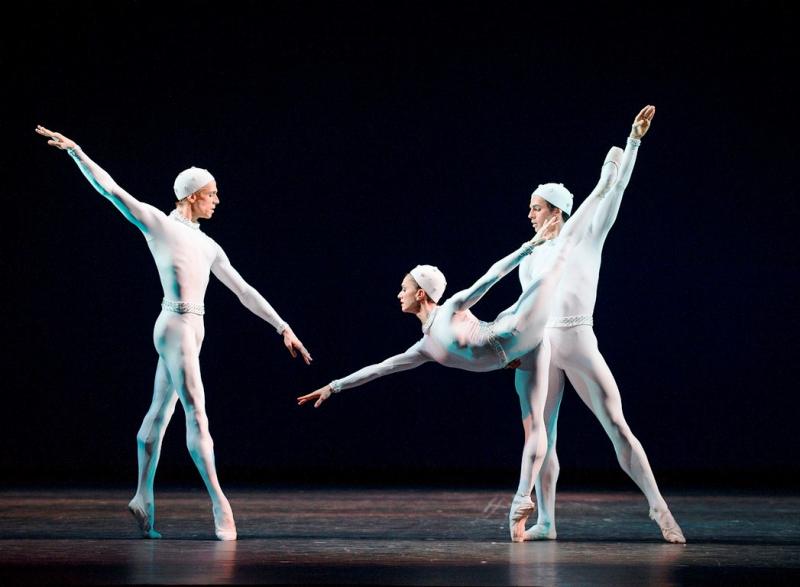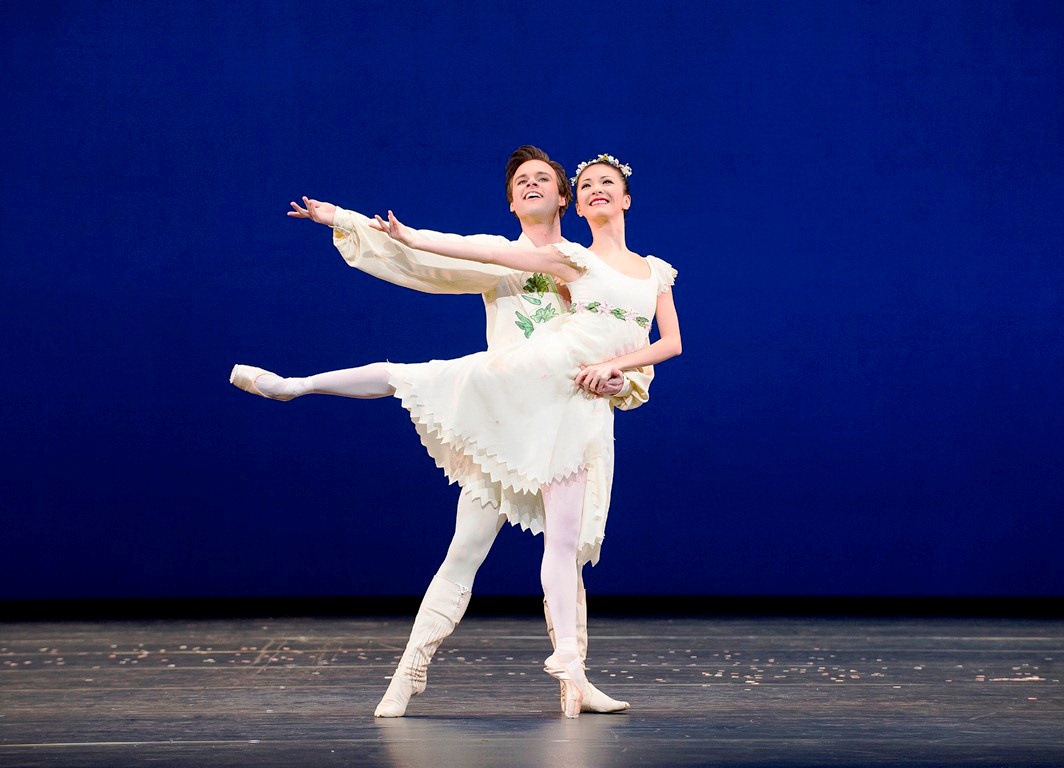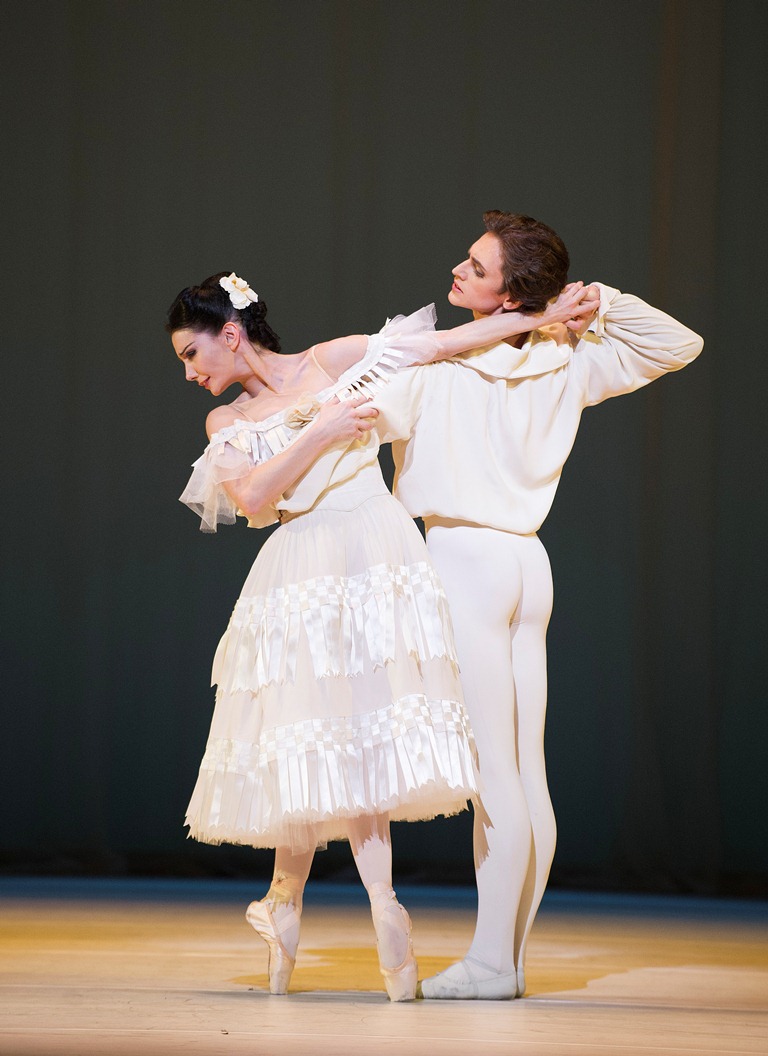La Valse/ Monotones/ Marguerite & Armand, Royal Ballet | reviews, news & interviews
La Valse/ Monotones/ Marguerite & Armand, Royal Ballet
La Valse/ Monotones/ Marguerite & Armand, Royal Ballet
A quarter of a century after Ashton's death, his legacy survives, and grows

Genius does not mean having no influences. Monotones, one of the very greatest of Frederick Ashton's ballets, is heavily influenced by other works: by George Balanchine’s Theme and Variations and Apollo, by Marius Petipa’s La Bayadère. And it in turn has influenced other great works: Kenneth MacMillan’s searing Gloria would not exist without this unearthly, moon-calm vision.
Monotones II, the second or “white” half, was created first, a gala piece which defies the usual fate of gala pieces. The starkness, the heroic simplicity and grace of this trio was immediately apparent, and Ashton choreographed a frontispiece, as it were, to introduce it. Monotones II features a woman and two men, and thus I was created to mirror its shape by being choreographed for two women and one man (all ably danced last night by, for I, Emma Maguire, Akane Takada and Dawid Trzensimiech; and for II, Marianela Nuñez, Federico Bonelli and Edward Watson).
The ebb and pulse of Erik Satie’s Gymnopédies and Gnossiennes suites permits Ashton to produce ribbons of dance: in Monotones I, a back-and-forth pull-push effect, at its most simple and beautiful in the travelling arabesques, the women then the man leading and returning, as though tied with invisible bonds; Monotones II is a more liquid unfurling of linked arms and posed arabesques, so seemingly unstoppable that, like the entry of the Shades in La Bayadère, the viewer feels bereft when the series ends.
 Two other gala pieces feature on this Royal Ballet Ashton commemoration (it is now a quarter-century since his death). The “Meditation” from Thaïs is a pas de deux that takes Massenet's well-known violin intermezzo and does, well, not much with it. The always valiant Leanne Benjamin does what she can, but her partner, Valeri Hristov, was not at his best last night, and was additionally burdened by Anthony Dowell’s Peter-Pan-does-the-Orient costume.
Two other gala pieces feature on this Royal Ballet Ashton commemoration (it is now a quarter-century since his death). The “Meditation” from Thaïs is a pas de deux that takes Massenet's well-known violin intermezzo and does, well, not much with it. The always valiant Leanne Benjamin does what she can, but her partner, Valeri Hristov, was not at his best last night, and was additionally burdened by Anthony Dowell’s Peter-Pan-does-the-Orient costume.
By contrast, Yuhui Choe and Alexander Campbell (pictured above right) made fine work of the Voices of Spring duet created for a production of Die Fledermaus. Campbell’s neat, beaten footwork was a pleasure (as is his Tintin-style quiff), and Choe’s little farewell flutter of her arms in the final lift was as joyous as it was unexpected.
 The star-power for the evening, however, was in Marguerite and Armand, Ashton’s retelling of the Alexandre Dumas story of La dame aux camélias. Originally choreographed for Margot Fonteyn and Rudolf Nureyev, it is heavy on attitudinizing, light on choreography, and apart from the pleasure of seeing (pictured left) Tamara Rojo (in her formal farewell to the Royal Ballet) and Sergei Polunin (in his formal let’s-make-friends-again return), the piece wears badly, with more dated costumes, this time by Cecil Beaton. (Do Marguerite’s admirers demand hardship pay for appearing in public in those dreadful wigs?)
The star-power for the evening, however, was in Marguerite and Armand, Ashton’s retelling of the Alexandre Dumas story of La dame aux camélias. Originally choreographed for Margot Fonteyn and Rudolf Nureyev, it is heavy on attitudinizing, light on choreography, and apart from the pleasure of seeing (pictured left) Tamara Rojo (in her formal farewell to the Royal Ballet) and Sergei Polunin (in his formal let’s-make-friends-again return), the piece wears badly, with more dated costumes, this time by Cecil Beaton. (Do Marguerite’s admirers demand hardship pay for appearing in public in those dreadful wigs?)
A patchy bill, therefore, but for the pleasure of Monotones, so rarely performed, almost anything is endurable.
Watch Alina Cojocaru and Johan Kobborg in Voices of Spring:
Share this article
Add comment
The future of Arts Journalism
You can stop theartsdesk.com closing!
We urgently need financing to survive. Our fundraising drive has thus far raised £49,000 but we need to reach £100,000 or we will be forced to close. Please contribute here: https://gofund.me/c3f6033d
And if you can forward this information to anyone who might assist, we’d be grateful.

Subscribe to theartsdesk.com
Thank you for continuing to read our work on theartsdesk.com. For unlimited access to every article in its entirety, including our archive of more than 15,000 pieces, we're asking for £5 per month or £40 per year. We feel it's a very good deal, and hope you do too.
To take a subscription now simply click here.
And if you're looking for that extra gift for a friend or family member, why not treat them to a theartsdesk.com gift subscription?
more Dance
 'We are bowled over!' Thank you for your messages of love and support
Much-appreciated words of commendation from readers and the cultural community
'We are bowled over!' Thank you for your messages of love and support
Much-appreciated words of commendation from readers and the cultural community
 R:Evolution, English National Ballet, Sadler's Wells review - a vibrant survey of ballet in four acts
ENB set the bar high with this mixed bill, but they meet its challenges thrillingly
R:Evolution, English National Ballet, Sadler's Wells review - a vibrant survey of ballet in four acts
ENB set the bar high with this mixed bill, but they meet its challenges thrillingly
 Like Water for Chocolate, Royal Ballet review - splendid dancing and sets, but there's too much plot
Christopher Wheeldon's version looks great but is too muddling to connect with fully
Like Water for Chocolate, Royal Ballet review - splendid dancing and sets, but there's too much plot
Christopher Wheeldon's version looks great but is too muddling to connect with fully
 iD-Reloaded, Cirque Éloize, Marlowe Theatre, Canterbury review - attitude, energy and invention
A riotous blend of urban dance music, hip hop and contemporary circus
iD-Reloaded, Cirque Éloize, Marlowe Theatre, Canterbury review - attitude, energy and invention
A riotous blend of urban dance music, hip hop and contemporary circus
 How to be a Dancer in 72,000 Easy Lessons, Teaċ Daṁsa review - a riveting account of a life in dance
Michael Keegan-Dolan's unique hybrid of physical theatre and comic monologue
How to be a Dancer in 72,000 Easy Lessons, Teaċ Daṁsa review - a riveting account of a life in dance
Michael Keegan-Dolan's unique hybrid of physical theatre and comic monologue
 A Single Man, Linbury Theatre review - an anatomy of melancholy, with breaks in the clouds
Ed Watson and Jonathan Goddard are extraordinary in Jonathan Watkins' dance theatre adaptation of Isherwood's novel
A Single Man, Linbury Theatre review - an anatomy of melancholy, with breaks in the clouds
Ed Watson and Jonathan Goddard are extraordinary in Jonathan Watkins' dance theatre adaptation of Isherwood's novel
 Peaky Blinders: The Redemption of Thomas Shelby, Rambert, Sadler's Wells review - exciting dancing, if you can see it
Six TV series reduced to 100 minutes' dance time doesn't quite compute
Peaky Blinders: The Redemption of Thomas Shelby, Rambert, Sadler's Wells review - exciting dancing, if you can see it
Six TV series reduced to 100 minutes' dance time doesn't quite compute
 Giselle, National Ballet of Japan review - return of a classic, refreshed and impeccably danced
First visit by Miyako Yoshida's company leaves you wanting more
Giselle, National Ballet of Japan review - return of a classic, refreshed and impeccably danced
First visit by Miyako Yoshida's company leaves you wanting more
 Quadrophenia, Sadler's Wells review - missed opportunity to give new stage life to a Who classic
The brilliant cast need a tighter score and a stronger narrative
Quadrophenia, Sadler's Wells review - missed opportunity to give new stage life to a Who classic
The brilliant cast need a tighter score and a stronger narrative
 The Midnight Bell, Sadler's Wells review - a first reprise for one of Matthew Bourne's most compelling shows to date
The after-hours lives of the sad and lonely are drawn with compassion, originality and skill
The Midnight Bell, Sadler's Wells review - a first reprise for one of Matthew Bourne's most compelling shows to date
The after-hours lives of the sad and lonely are drawn with compassion, originality and skill
 Ballet to Broadway: Wheeldon Works, Royal Ballet review - the impressive range and reach of Christopher Wheeldon's craft
The title says it: as dancemaker, as creative magnet, the man clearly works his socks off
Ballet to Broadway: Wheeldon Works, Royal Ballet review - the impressive range and reach of Christopher Wheeldon's craft
The title says it: as dancemaker, as creative magnet, the man clearly works his socks off
 The Forsythe Programme, English National Ballet review - brains, beauty and bravura
Once again the veteran choreographer and maverick William Forsythe raises ENB's game
The Forsythe Programme, English National Ballet review - brains, beauty and bravura
Once again the veteran choreographer and maverick William Forsythe raises ENB's game

Comments
I have the impression that,
I think Judith Flanders was
Each to their own of course,
I enjoyed the entire bill,
I fail to see how could
Why is it pretentious to
Absolutely agree that